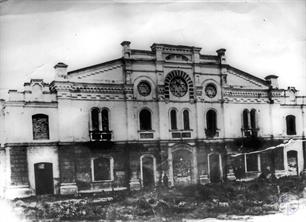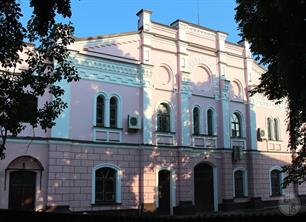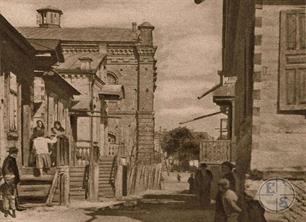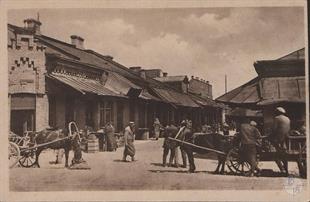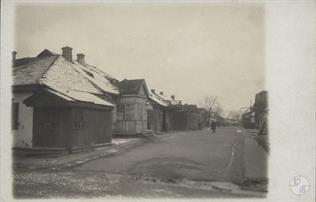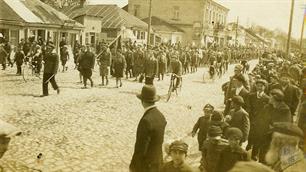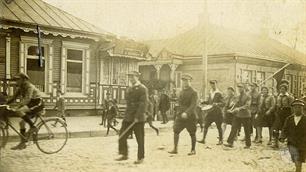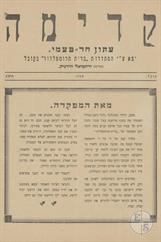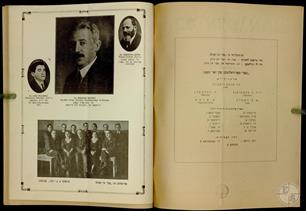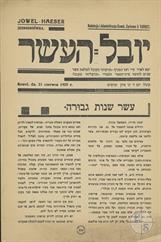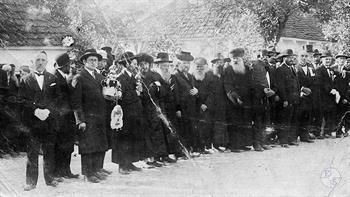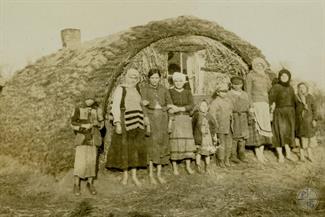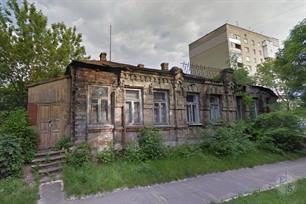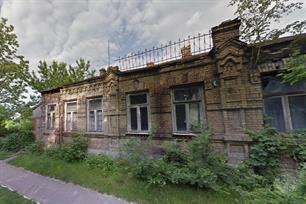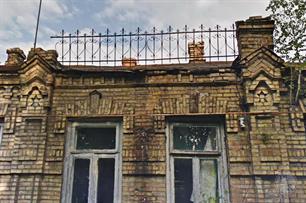Kovel
Kovel district, Volyn region
Sources:
- Jewish encyclopedia of Brockhaus & Efron;
- Russian Jewish encyclopedia;
- The All South-Western Territory: reference and address book of the Kyiv, Podolsk and Volyn provinces. Printing house L.M. Fish and P.E. Wolfson, 1913;
- Virtual Shtetl. Kovel
Photo:
- European Jewish Cemeteries Initiative. Kovel Jewish Cemetery;
- Austrian National Library
- Eva Maria Kraiss, The Center for Jewish Art
- Yad Vashem Photo Archive. Kowel
- Protecting Memory. Bakhiv (Kovel)
- Library of Congress. Jewish Family Outside Their Temporary Home, Poland
- Biblioteka Narodowa Polona. Kowel
- Tomek Wisniewski, Bagnowka. Kowel
- Jewish encyclopedia of Brockhaus & Efron;
- Russian Jewish encyclopedia;
- The All South-Western Territory: reference and address book of the Kyiv, Podolsk and Volyn provinces. Printing house L.M. Fish and P.E. Wolfson, 1913;
- Virtual Shtetl. Kovel
Photo:
- European Jewish Cemeteries Initiative. Kovel Jewish Cemetery;
- Austrian National Library
- Eva Maria Kraiss, The Center for Jewish Art
- Yad Vashem Photo Archive. Kowel
- Protecting Memory. Bakhiv (Kovel)
- Library of Congress. Jewish Family Outside Their Temporary Home, Poland
- Biblioteka Narodowa Polona. Kowel
- Tomek Wisniewski, Bagnowka. Kowel
Kovel, city (from 1518), district center in the Volyn region. Known from 1310. In 1518 he received Magdeburg law. In the 16–18 centuries - the city of Vladimir’s powiat of the Volyn Voivodeship as part of the Commonwealth. Since 1795 - as part of the Russian Empire. In the 19th - beginning of the 20th century, the county city of the Volyn province. In 1919–39 - in the Volyn Voivodeship as part of Poland, in 1939–91 - as part of the Ukrainian SSR.
In 1765, 827 Jews lived in Kovel,
in 1790 - 428,
in 1847 - 2647,
in 1884 - 5182,
in 1897 - 8521 (48%),
in 1910 - 11 748 (45.6%),
in 1921 –12 758 (61.2%),
in 1931 - 12 842 (c. 50%),
in 1970 - approx. 250 Jews.
In 1765, 827 Jews lived in Kovel,
in 1790 - 428,
in 1847 - 2647,
in 1884 - 5182,
in 1897 - 8521 (48%),
in 1910 - 11 748 (45.6%),
in 1921 –12 758 (61.2%),
in 1931 - 12 842 (c. 50%),
in 1970 - approx. 250 Jews.
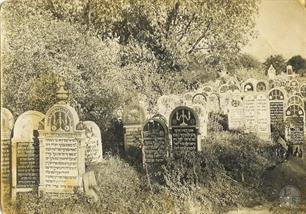 |
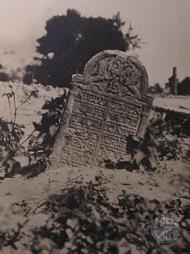 |
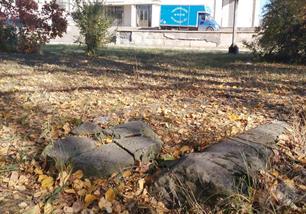 |
| New Jewish cemetery, 1938 | Cemetery in Kovel, 1916. The tombstone of Chaya and her husband Moshe | New Jewish cemetery, 2019 |
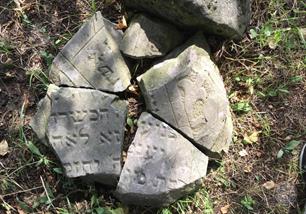 |
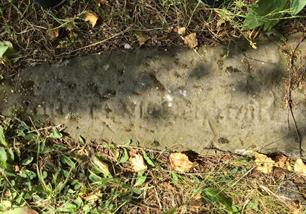 |
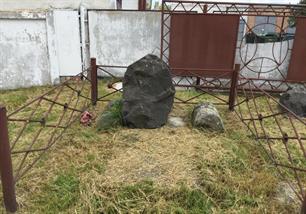 |
| Old Jewish cemetery, 2019 |
The Jewish community appeared in Kovel after King Zygmunt Stary granted town rights to the locality in 1518. In 1536, Queen Bona, while confirming the privilege, obliged Kovel Jews to participate in the renovation of the town’s walls and bridges. In 1547, the queen established a fixed tax, called podworne (manor tax), payable for each Jewish-owned house (apart from the house of the rabbi); she also granted Jews rights and duties equal to the Christian population. The extensive commercial connections of the local community, reaching as far as the Tatar fortress of Ochakiv on the coast of the Black Sea, were the source of significant profit for the monarch.
In 1556, in response to the demands of the local population, separate streets were designated for Jews, who were forced to buy Christian houses located in the area. In 1565, King Zygmunt II August granted the ownership of Kovel to Knyaz Andrey Kurbsky from Moscow, who began to extort money from Jews. In 1569, his deputy sealed the synagogue and all Jewish houses and shops in the town, and then threw three Jews into a prison pit; such lawless deeds were later abrogated by a royal decree.
In 1556, in response to the demands of the local population, separate streets were designated for Jews, who were forced to buy Christian houses located in the area. In 1565, King Zygmunt II August granted the ownership of Kovel to Knyaz Andrey Kurbsky from Moscow, who began to extort money from Jews. In 1569, his deputy sealed the synagogue and all Jewish houses and shops in the town, and then threw three Jews into a prison pit; such lawless deeds were later abrogated by a royal decree.
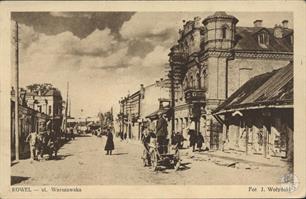 |
 |
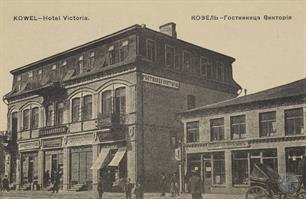 |
| Varshavska Street, 1915-1918 | Alexandr II Street, 1915-1918 | Hotel Victoria, 1915-1918 |
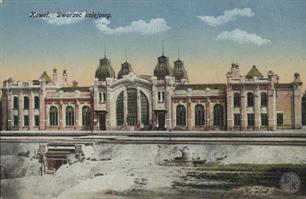 |
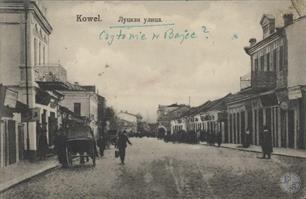 |
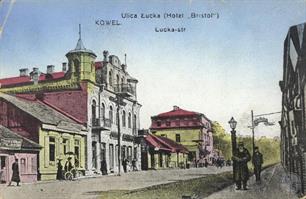 |
| Railway station, 1915-1918 | Lutska Street, 1915-1918 | Hotel Bristol, 1915-1918 |
In 1614, Jews were granted the right to settle and own houses in all parts of Kovel. In 1618, Jewish tailors and furriers joined Christian craft guilds. During the Khmelnystky Uprising, the Cossacks and some Orthodox inhabitants of Kovel drowned Jews and Catholics in the local river.
In 1650, the Jewish community was revived on the basis of old privileges confirmed by King Jan Kazimierz. In 1651, there were 20 Jewish houses in Kovel, and in 1660 a synagogue was built (it burned down in 1744).
In the 16th and the 17th century, the most famous rabbis of Kovel and heads of the local yeshiva were Szymszon and Itskhak ben Natan Shapiro, as well as Jehuda, descendant of Jehuda Liwa ben Becalel.
In 1650, the Jewish community was revived on the basis of old privileges confirmed by King Jan Kazimierz. In 1651, there were 20 Jewish houses in Kovel, and in 1660 a synagogue was built (it burned down in 1744).
In the 16th and the 17th century, the most famous rabbis of Kovel and heads of the local yeshiva were Szymszon and Itskhak ben Natan Shapiro, as well as Jehuda, descendant of Jehuda Liwa ben Becalel.
In 1717, two Jewish families from Kovel settled in Medzhibozh.
The Jewish population of Kovel grew in the 18th century. In 1765, there were 827 Jewish tax payers in the town. When Tzaddik Mordechaj of Niesuchojeże (1752-1800) settled in Kovel, the town became a centre of Hasidism.
After 1795, the Russian authorities chose a deputy mayor from among the Jews.
A fire which broke out in the town in 1857 destroyed almost all buildings (including the synagogue), but Kovel was soon rebuilt. In the 1870s, the town underwent a period of intense development connected with the construction of railway lines. Kovel again became an important center of trade.
The Jewish population of Kovel grew in the 18th century. In 1765, there were 827 Jewish tax payers in the town. When Tzaddik Mordechaj of Niesuchojeże (1752-1800) settled in Kovel, the town became a centre of Hasidism.
After 1795, the Russian authorities chose a deputy mayor from among the Jews.
A fire which broke out in the town in 1857 destroyed almost all buildings (including the synagogue), but Kovel was soon rebuilt. In the 1870s, the town underwent a period of intense development connected with the construction of railway lines. Kovel again became an important center of trade.
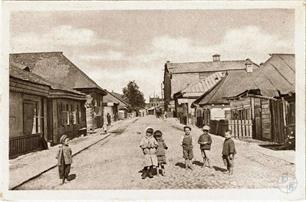 |
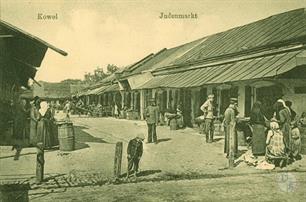 |
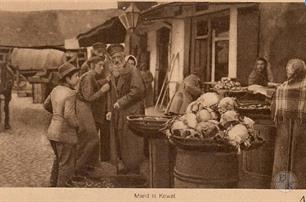 |
| Kovel, 1916. Bayernshtrasse Street, Synagogue is visible on the right | Kovel, 1915-1918. Yudenmarkt (Jevish market) | Kovel, 1915-1918. Jews on the market |
In 1865 there were 4 synagogues in Kovel, in 1889 - 8, in 1902 - 10 (including 7 Hasidic), in 1910 - 13 synagogues.
In 1897, Kovel had 8,521 Jewish inhabitants (48% of the total population).
The city functioned a Jewish hospital (since 1880), Talmud-Tora (since 1885), a mutual loan society (since 1891), a night shelter (since 1899), an almshouse (since 1901), 3 private male schools and 2 women's Jewish schools, society for caring for the Jewish children (since 1909).
There were 2 Jewish cemeteries (tombstones of 1550 were preserved on the old one).
In 1897, Kovel had 8,521 Jewish inhabitants (48% of the total population).
The city functioned a Jewish hospital (since 1880), Talmud-Tora (since 1885), a mutual loan society (since 1891), a night shelter (since 1899), an almshouse (since 1901), 3 private male schools and 2 women's Jewish schools, society for caring for the Jewish children (since 1909).
There were 2 Jewish cemeteries (tombstones of 1550 were preserved on the old one).
In 1919, a pogrom occurred in Kovel, arranged by the Directory detachments, in 1920-Bulak-Balakhovich detachments.
In 1921, ca. 13,000 Jews lived in Kovel (61.2% of the population). They worked mainly in the light industry, in breweries and leather plants, in construction, or in craft workshops. They dealt in wholesale and retail trade. Half of the members of the town council were Jews.
The 20th century saw intense development of the Jewish political life. The Hovevei Zion group was established in 1894. In 1904, the Bund launched an extensive propaganda campaign and became involved in organisational activities. The Zionist movement started to gain momentum in the years 1919-1939. Most of the Orthodox Jews living in Kovel belonged to the Agudath party.
The Tarbut organisation greatly contributed to the promotion of national awareness among Jews. In the interwar period, it ran a kindergarten, two primary schools, and a lower secondary school (est. 1921).
In 1921, ca. 13,000 Jews lived in Kovel (61.2% of the population). They worked mainly in the light industry, in breweries and leather plants, in construction, or in craft workshops. They dealt in wholesale and retail trade. Half of the members of the town council were Jews.
The 20th century saw intense development of the Jewish political life. The Hovevei Zion group was established in 1894. In 1904, the Bund launched an extensive propaganda campaign and became involved in organisational activities. The Zionist movement started to gain momentum in the years 1919-1939. Most of the Orthodox Jews living in Kovel belonged to the Agudath party.
The Tarbut organisation greatly contributed to the promotion of national awareness among Jews. In the interwar period, it ran a kindergarten, two primary schools, and a lower secondary school (est. 1921).
In 1923, the ORT organisation (the Society for the Promotion of Vocational and Agricultural Work among Jews) opened a vocational school in Kovel.
The cultural life of the Jewish community developed thanks to three public libraries, a drama club, and the I.L. Perec Club.
Two Yiddish weeklies were published in the town: the Kovler shtime (1927-1939) and the Unzer leben (1936-1939).
Various sports clubs were active in the town, among them the Maccabi, Bar-Kochba, and Kadima.
Since 1903, after the death of his father-in-law, Rabbi Moishe Zakham, the rabbi in Kovel became Yomtov-lipman chic (1870–?).
In the 1910s a tsadik from Trisk Yakov-Laib Tversky settled in the Kovel.
In 1914, the spiritual rabbi was Itskhok Krause, the official rabbi was Joseph Brik.
In 1939, ca. 17,000 Jews lived in Kovel (about 50% of the total population). The Soviet occupation of eastern Poland, which started in September 1939, brought an end to all aspects of organised Jewish social life. Hebrew ceased to be the language of instruction in all Jewish schools and kindergartens, and was replaced by Yiddish.
The municipality of Kovel was 50% of Jews.
The rabbis in the 1920-30s were Eliezer Nietzberg and Isroel-Moshe Yagodnik.
The cultural life of the Jewish community developed thanks to three public libraries, a drama club, and the I.L. Perec Club.
Two Yiddish weeklies were published in the town: the Kovler shtime (1927-1939) and the Unzer leben (1936-1939).
Various sports clubs were active in the town, among them the Maccabi, Bar-Kochba, and Kadima.
Since 1903, after the death of his father-in-law, Rabbi Moishe Zakham, the rabbi in Kovel became Yomtov-lipman chic (1870–?).
In the 1910s a tsadik from Trisk Yakov-Laib Tversky settled in the Kovel.
In 1914, the spiritual rabbi was Itskhok Krause, the official rabbi was Joseph Brik.
In 1939, ca. 17,000 Jews lived in Kovel (about 50% of the total population). The Soviet occupation of eastern Poland, which started in September 1939, brought an end to all aspects of organised Jewish social life. Hebrew ceased to be the language of instruction in all Jewish schools and kindergartens, and was replaced by Yiddish.
The municipality of Kovel was 50% of Jews.
The rabbis in the 1920-30s were Eliezer Nietzberg and Isroel-Moshe Yagodnik.
On 28 June 1941, Kovel was seized by Germans. Only a small part of the Jewish population managed to leave the town. Ca. 1,000 Jews were murdered in the first days of the occupation. The group, composed primarily of men who had ties to the communist apparatus (or at least were accused of having them), was shot in the Czerewacha forest. A twelve-member Judenrat was organised in the town on the German order.
On 21 May 1942, two ghettos were set up in Kovel. One of them, the so-called Piaski (Sands), was a ghetto for the able-bodied and members of their families. It housed ca. 8,000 people. The other one was created in the suburbs, at Brzeska Street, and housed 6,000 Jews classified as ‘parasites and invalids.’
On 2-3 July 1942, prisoners from the latter were driven outside the town and murdered in the village of Bachov.
On 19 August 1942, Germans began to liquidate the ghetto for the able-bodied. Some Jews tried to escape into the forest, but most were killed by gangs of Ukrainian nationalists.
As early as May 1942, a resistance group had been organised in the ghetto with the help of two representatives of the Jewish underground from Warsaw. During the liquidation of the district, its inhabitants attempted to mount armed resistance, but they were quickly suppressed by Germans. The last prisoners of the Kovel Ghetto were murdered in Bachov on 6 October 1942.
On 21 May 1942, two ghettos were set up in Kovel. One of them, the so-called Piaski (Sands), was a ghetto for the able-bodied and members of their families. It housed ca. 8,000 people. The other one was created in the suburbs, at Brzeska Street, and housed 6,000 Jews classified as ‘parasites and invalids.’
On 2-3 July 1942, prisoners from the latter were driven outside the town and murdered in the village of Bachov.
On 19 August 1942, Germans began to liquidate the ghetto for the able-bodied. Some Jews tried to escape into the forest, but most were killed by gangs of Ukrainian nationalists.
As early as May 1942, a resistance group had been organised in the ghetto with the help of two representatives of the Jewish underground from Warsaw. During the liquidation of the district, its inhabitants attempted to mount armed resistance, but they were quickly suppressed by Germans. The last prisoners of the Kovel Ghetto were murdered in Bachov on 6 October 1942.
July 7, 1944 ca. 40 Jews returned to the city.
The Jewish community of Kovel did not completely disappear after the war. Ca. 250 Jews (50 families) inhabited the town in 1970, but all of them left over the following years. Not a single Jew was listed in the census of Kovel carried out in 2001.
The Jewish community of Kovel did not completely disappear after the war. Ca. 250 Jews (50 families) inhabited the town in 1970, but all of them left over the following years. Not a single Jew was listed in the census of Kovel carried out in 2001.

- Home
- Shtetls
- Vinnytsia region
- Volyn region
- Dnipro region
- Donetsk region
- Zhytomyr region
- Zakarpattia region
- Zaporizhzhia region
- Ivano-Frankivsk region
- Kyiv region
- Kropyvnytskyi region
- Luhansk region
- Lviv region
- Mykolayiv region
- Odessa region
- Poltava region
- Rivne region
- Sumy region
- Ternopil region
- Kharkiv region
- Kherson region
- Khmelnytskyi region
- Chernihiv region
- Chernivtsi region
- Cherkasy region
- Crimea
- Synagogues
- Cemeteries
- Objects & guides
- Old photos
- History
- Contact
Jewish towns of Ukraine
My shtetl
My shtetl
Donate
Jewish towns of Ukraine
